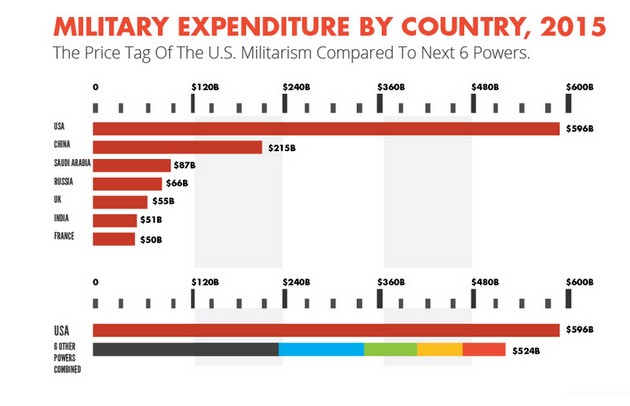The US
War Machine’s Annual Budget Could Buy Every
Homeless American a $1 Million Home
By Jay
Syrmopoulos
May 22,
2016 "Information
Clearing House"
- "FTP"
-
Washington, D.C. – In 2015, the United States
spent more on its war machine than the next six
countries combined, with a total of
$596 billion spent on military expenditures.
This week the U.S. House of Representatives
passed its version of the annual National
Defense Authorization Act (NDAA), with roughly
$602 billion slated to be spent on military
programs and armaments in the 2017 budget.
To put
this amount in perspective, the U.S. spent more
on its military than the next six nations
combined, with China coming in second at $215
billion, followed by Saudi Arabia at $87
billion, Russia at $66 billion, with the United
Kingdom, India and France spending roughly $50
billion each on defense expenses.

When
looking at this spending in context, the U.S.
not only spends more than the next six countries
combined, but spends almost triple the amount on
military expenses than the second biggest
defense spender in the world, China, according
to data from the Stockholm International Peach
Research Institute.
These
figures come on top of the recently announced
$1 trillion dollar nuclear missile modernization
program that has been curiously absent from
public discourse, having not even been mentioned
in the televised presidential debates.
All of
this comes as the U.S. pivots from the “Global
War on Terror,“ to a more traditional defense
posture. The reasoning behind this is simple;
who needs new tanks, bombers, fighters and
missiles to fight ISIS or al-Qaeda? There simply
wasn’t enough money to be made in bombing
jihadists in tents in the desert, thus the drums
of war in the media, regarding an
“aggressive Russia,” began to be played as
to allow for the return of traditional
military-industrial complex/Cold War posturing.
The
sheer enormity of the sums being given to
the military-industrial complex is enough to
boggle the mind. Think for a moment how else
that $600 billion could be spent to actually
assist in creating growth rather than death.
Consider that in January 2015, the U.S.
Department of Housing and Urban Development
(HUD) found there were
564,708 homeless people on a given night in
the United States – the government could
actually purchase a $1 million dollar home
for each individual homeless person in the
U.S. and still have money left over.
Or
perhaps the money could be spent on the
rapidly eroding domestic U.S. nuclear
infrastructure. Although the media spotlight
is rarely shined upon America’s aging
nuclear infrastructure, U.S. nuclear power
plants are decaying rapidly, precipitating
numerous nuclear environmental disasters
across the country. The Free Thought Project
recently reported on
four nuclear disasters playing out
across the country, with massive amounts of
radioactive material having been leaked.
Rather than investing in these terminal
goods, such as bombs and bullets, which are
meant for destruction, we should be
investing in capital goods that are able to
provide growth. The U.S. war machine spends
hundreds of billions of dollars per year
waging war against humanity, while Americans
at home are dying from a crumbling nuclear
infrastructure and crippling poverty.